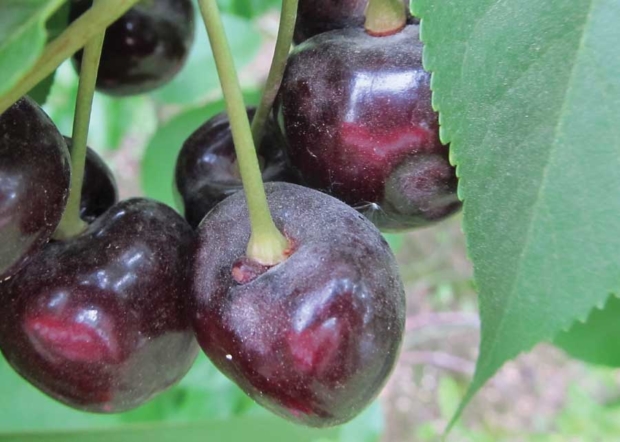
A WSU study into powdery mildew looked at the effectiveness of applying fungicide early in the season, at midseason and late in the season. (Courtesy Claudia Probst)
Given the prevalence of powdery mildew in cherries, Washington State University researchers have spent two years — and will continue for a third — examining the effectiveness of spray applications for the disease.
The intent of the study is to see if there is a critical spray period during which the application of Quintec (quinoxyfen), a widely used fungicide in Washington, is most beneficial, said Dr. Claudia Probst, research associate at WSU’s Irrigated Agriculture Research and Extension Center in Prosser, Washington.
Specifically, is the fungicide more effective early in the season, at midseason or late season?
Fungicide review
The study is being conducted at WSU’s Irrigated Agriculture Research and Extension Center in Prosser, Washington, in a one-acre research orchard using a completely randomized experimental setup with four, single-tree replicates per treatment.
In addition to Quintec, the study examined the use of Fontelis (penthiopyrad) and Pristine (boscalid, pyraclostrobin) — as well as Fontelis in combination with Quintec, varying which fungicide was sprayed at different times — to determine the best treatment when compared with untreated trees. In all, eight treatments were tested.
Usually, growers would never apply a single fungicide, and in theory, all of these fungicides work to treat powdery mildew, Probst said. But a statistical analysis helps to determine if one works better than another, or in combination, when compared to the untreated control block of trees.
Overall, researchers found there was no critical spray period. None of the treatments showed significant improvement controlling incidence of mildew on leaves in either year, except for one combination of Fontelis and Quintec in 2014. However, several treatments showed promise for controlling the severity of the disease on leaves and fruit, even though the effect was only observed in one year.
For fruit, Pristine was the only fungicide that controlled both incidence and severity of the disease on fruit in both years, the research showed.
“That was a little unexpected. I would have thought the other fungicides would do really well,” she said. “Some fungicides just seem to do better at controlling foliar infection, and others are better at controlling fruit infection. Overall, the incidence of disease on leaves is not a good indicator on how much disease to expect on fruit.”
Quintec alone also did not control incidence or severity of the disease on leaves or fruit either year, the study showed. The Quintec-Fontelis spray rotations controlled fruit disease incidence and severity — and leaf severity — in 2014, but not in 2015. A similar trend was observed in two similar spray trials conducted in Quincy, Washington.
“Growers really like Quintec, because it’s a novel mode of action fungicide, and it’s the only one within this FRAC group,” Probst said. “We wanted to see the best time to apply it, but it turns out, there wasn’t a best time.”
Quintec appears to lose a little bit of its efficiency over the years, she said, which could suggest there’s fungal resistance building up. The researchers will examine that further in year three of the study.
“I don’t think it was just the season or the heat last year,” Probst said of the possibility of resistance developing. “It’s more of a gut feeling, which is backed up by the results from similar trials and observations made by collaborators in Washington and Oregon, but we should know more after this year.”
The fungicide applications did not affect fruit quality or pitting susceptibility. •
– by Shannon Dininny







Leave A Comment